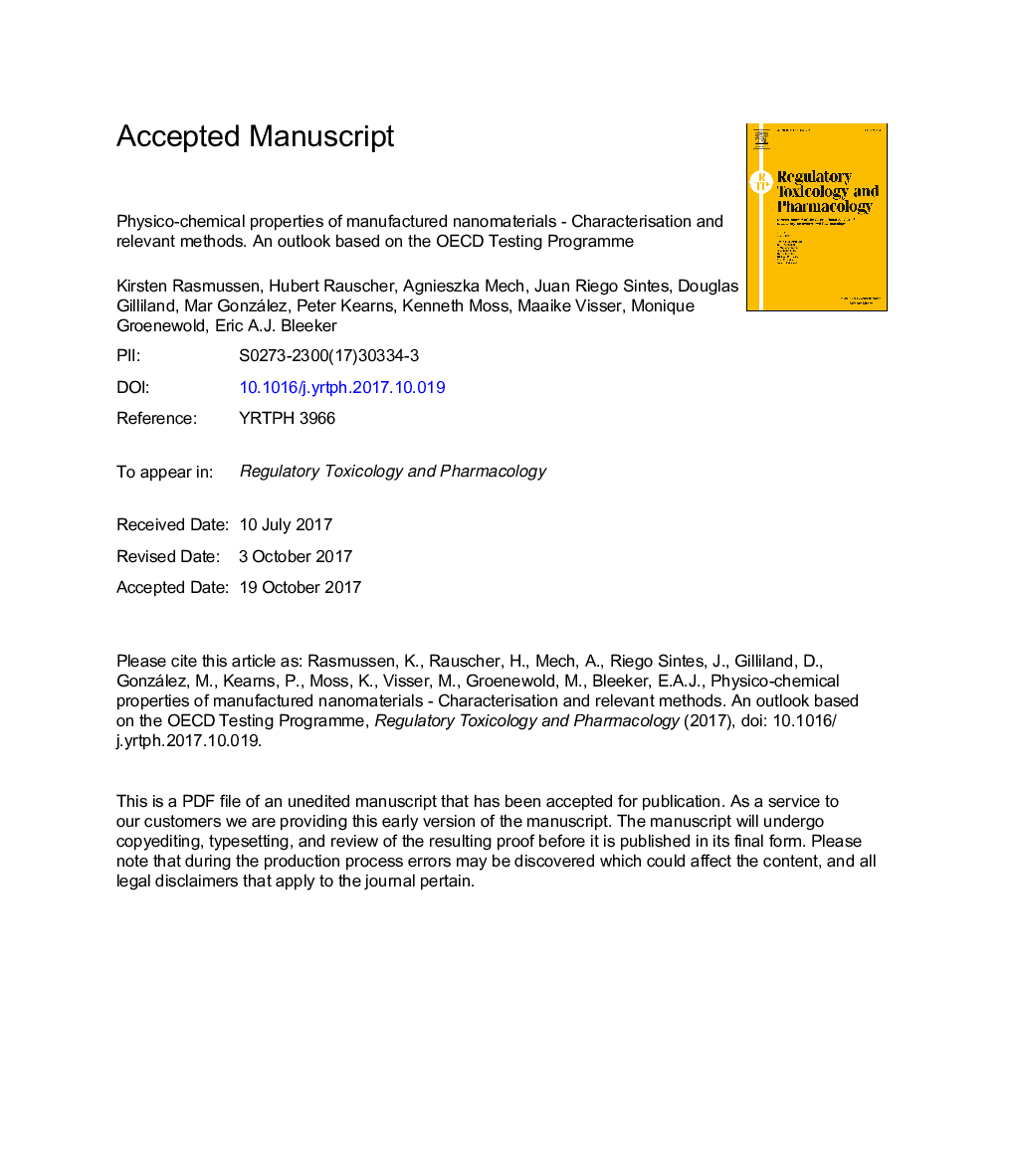| کد مقاله | کد نشریه | سال انتشار | مقاله انگلیسی | نسخه تمام متن |
|---|---|---|---|---|
| 8551803 | 1562110 | 2018 | 74 صفحه PDF | دانلود رایگان |
عنوان انگلیسی مقاله ISI
Physico-chemical properties of manufactured nanomaterials - Characterisation and relevant methods. An outlook based on the OECD Testing Programme
دانلود مقاله + سفارش ترجمه
دانلود مقاله ISI انگلیسی
رایگان برای ایرانیان
کلمات کلیدی
CLSSMPSESRCNTWAXSTGPSWCNTPOMSDRMWCNTORPOECDICPFFFDTASSASTMCENAFMSAXSOECD test guidelinesWPMNJRCguidance documentUV-VisDLSnuclear magnetic resonance - رزونانس مغناطیسی هستهایAes - AESDOSY NMR - NMR DOSROS - ROSTof-SIMS - TOF-SIMSDifferential Thermal Analysis - آنالیز حرارتی تفاضلی، گرماسنجی تفاضلیELS - آنهاwide angle X-ray scattering - اشعه ایکس اشعه ایکس پراکندگیenergy dispersive X-ray spectrometry - اشعه ماوراء بنفش اشعه ایکس پراکندهISO - ایزوTem - این استOES - بلهFourier-transform infrared spectroscopy - تبدیل فوریه طیف سنجی مادون قرمزField flow fractionation - تجزیه میدان جریان میدانNMR - تشدید مغناطیسی هستهای Electron paramagnetic resonance - تشدید پارامغناطیس الکترونEPR - تشدید پارامغناطیس الکترونCharacterisation - تعیین مشخصاتmanufactured nanomaterials - تولید نانوموادPhysico-chemical properties - خواص فیزیکی و شیمیاییtwo dimensional - دو بعدیSingle particle - ذرات تکElectron spin resonance - رزونانس اسپین الکترونInternational Organisation for Standardisation - سازمان بین المللی استاندارد سازیOrganisation for Economic Co-operation and Development - سازمان همکاری اقتصادی و توسعهSpecific surface area - سطح خاصthree dimensional - سه بعدیSIMS - سیمزBET - شرطAuger electron spectroscopy - طیف سنج الکترونی آگرFTIR - طیف سنج مادون قرمزTime-of-Flight Secondary Ion Mass Spectrometry - طیف سنجی جرم یونی ثانویه زمان پروازsecondary ion mass spectrometry - طیف سنجی جرم یونی ثانویه یا طیف نگاری جرم یونی ثانویهMass spectrometry - طیف سنجی جرمیX-ray photoelectron spectroscopy - طیف سنجی فوتوالکتر اشعه ایکسXRF - طیف نگاری فلوئورسانس اشعه ایکسXPS - طیف نگاری فوتوالکترونی اشعه ایکسX-ray fluorescence - فلورسانس اشعه ایکسMALS - مالشSEM - مدل معادلات ساختاری / میکروسکوپ الکترونی روبشیElectron microscopy - میکروسکوپ الکترونیScanning electron microscopy - میکروسکوپ الکترونی روبشیTransmission electron microscopy - میکروسکوپ الکترونی عبوریScanning tunnelling microscopy - میکروسکوپ تونلی اسکن کردنatomic force microscopy - میکروسکوپ نیروی اتمیCarbon nanotube - نانولوله کربنیSingle-walled carbon nanotube - نانولوله کربنی تک دیوارهMulti-walled carbon nanotube - نانولوله کربنی چند دیوارهNanomaterial - نانومواد X-ray diffraction - پراش اشعه ایکسXRD - پراش اشعه ایکسsmall angle X-ray Scattering - پراکندگی اشعه ایکس زاویه کوچکElectrophoretic light scattering - پراکندگی نور الکتروفورزDynamic Light Scattering - پراکندگی نور دینامیکیmulti-angle light scattering - پراکندگی نور چند زاویهinductively coupled plasma - پلاسما جفتشده القاییDifferential scanning calorimetry - کالریمتری روبشی افتراقیReactive oxygen species - گونههای فعال اکسیژن
موضوعات مرتبط
علوم زیستی و بیوفناوری
علوم محیط زیست
بهداشت، سم شناسی و جهش زایی
پیش نمایش صفحه اول مقاله

چکیده انگلیسی
Identifying and characterising nanomaterials require additional information on physico-chemical properties and test methods, compared to chemicals in general. Furthermore, regulatory decisions for chemicals are usually based upon certain toxicological properties, and these effects may not be equivalent to those for nanomaterials. However, regulatory agencies lack an authoritative decision framework for nanomaterials that links the relevance of certain physico-chemical endpoints to toxicological effects. This paper investigates various physico-chemical endpoints and available test methods that could be used to produce such a decision framework for nanomaterials. It presents an overview of regulatory relevance and methods used for testing fifteen proposed physico-chemical properties of eleven nanomaterials in the OECD Working Party on Manufactured Nanomaterials' Testing Programme, complemented with methods from literature, and assesses the methods' adequacy and applications limits. Most endpoints are of regulatory relevance, though the specific parameters depend on the nanomaterial and type of assessment. Size (distribution) is the common characteristic of all nanomaterials and is decisive information for classifying a material as a nanomaterial. Shape is an important particle descriptor. The octanol-water partitioning coefficient is undefined for particulate nanomaterials. Methods, including sample preparation, need to be further standardised, and some new methods are needed. The current work of OECD's Test Guidelines Programme regarding physico-chemical properties is highlighted.
ناشر
Database: Elsevier - ScienceDirect (ساینس دایرکت)
Journal: Regulatory Toxicology and Pharmacology - Volume 92, February 2018, Pages 8-28
Journal: Regulatory Toxicology and Pharmacology - Volume 92, February 2018, Pages 8-28
نویسندگان
Kirsten Rasmussen, Hubert Rauscher, Agnieszka Mech, Juan Riego Sintes, Douglas Gilliland, Mar González, Peter Kearns, Kenneth Moss, Maaike Visser, Monique Groenewold, Eric A.J. Bleeker,